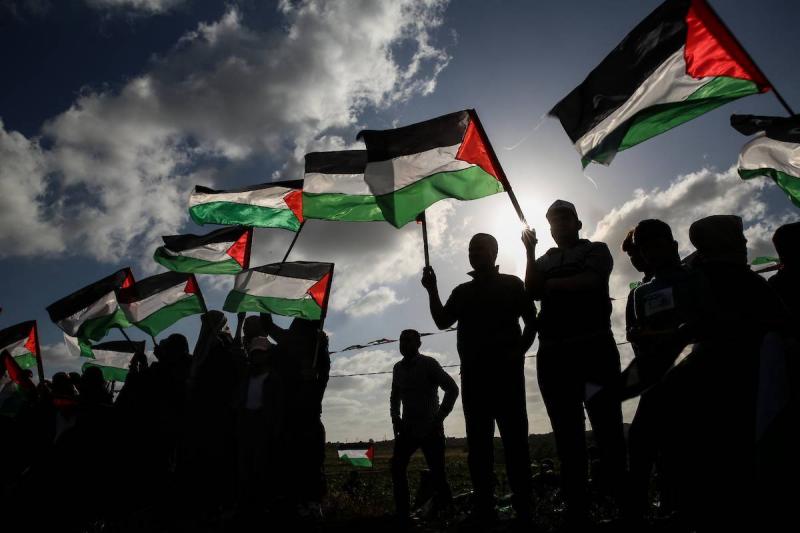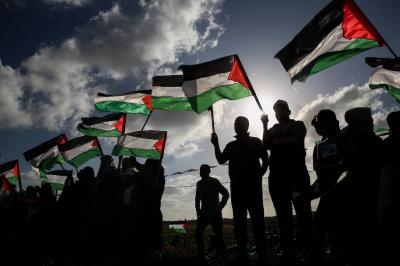The events of October 7th represented an unexpected blow to Israel, revealing a significant failure on the part of the Israeli political leadership, military, and intelligence systems. This failure was not only due to the surprise element that "Hamas" used against Israel, but also because the military capabilities of the seven main brigades on the ground, especially "Al-Qassam," the armed wing of Hamas, appeared more advanced than Israel had known or expected. "Al-Qassam Brigades" is the most significant military force among armed wings in all Palestinian territories, noted for its personnel and equipment, showcasing strong discipline and high-level training. Additionally, there are other active fighting factions in the Gaza Strip that "Asharq Al-Awsat" highlights.
**Al-Qassam Brigades (formerly known as Magd)**
Currently, Al-Qassam Brigades are the largest military force in the Gaza Strip and all Palestinian territories. Established in early 1988 as "Magd," they were renamed a few months later. The name "Magd" remained associated with their secret security apparatus to track down collaborators working for Israeli intelligence. One of its prominent founders is Yahya Sinwar, the current leader of Hamas in Gaza and Israel's number one target for supposedly masterminding the attacks on October 7th. The Brigades have gone through several phases since their inception, with a clear emergence in 1994, marked by attempts to kidnap Israelis and a successful operation in the West Bank involving the capture of soldier Nachshon Wachsman, who was killed by Israeli forces alongside his captors. Al-Qassam gained significant notoriety in the early 1990s for carrying out bombings inside Israel, and Yahya Ayyash, one of their prominent leaders in the West Bank, became a symbol of the movement after Israeli attempts to assassinate him failed, earning the nickname "the Engineer," until he was killed in Gaza in a bombing in 1996. The bombing operations characteristic of Al-Qassam continued during the Second Intifada, highlighted by the capture of soldier Gilad Shalit in 2006, whom they held for several years, forcing Israel into a prisoner exchange deal in 2011 that resulted in the release of 1,027 prisoners. In 2007, Al-Qassam established military control over Gaza following clashes with Palestinian Authority security forces, decisively winning the battle in a few hours. They trialed launching primitive rockets at Israel throughout the Intifada, which Palestinian officials described as "futile," yet surprised Israel by firing "Grad" missiles reaching about 50 km at the beginning of 2009. In the following years, they developed their capabilities, built public military sites, organized hierarchically, and recruited thousands among their fighters, with estimates suggesting they have around 30,000 fighters. Their forces are categorized into "elite units" and brigades by geographical areas, with specialized units for tunnels, military manufacturing, and intelligence. Al-Qassam operates both defensive and offensive tunnels that have significantly concerned the Israeli military, successfully using them extensively during the 2014 war, which lasted 51 days. They managed to conceal two Israeli soldiers they captured from the Al-Tuffah neighborhood in eastern Gaza City and from Rafah in southern Gaza, with their fate still unknown. Al-Qassam struck Tel Aviv with an Iranian-made "Fajr" missile for the first time in 2012 in response to the assassination of their prominent leader Ahmed Jabari. They subsequently developed drones and dozens of missiles that caught Israel by surprise in other conflicts, including the 2014 war and the 2021 "Sword of Al-Quds" operation, which began with missile strikes against Jerusalem, as well as in the current war. Notable leaders killed by Israel include Yahya Ayyash, Imad Aqil, Salah Shehada, Fawzi Abu Qir'a, Ahmed Jabari, Raed Al-Attar, and Ahmed Al-Ghandour, while Mohammed Al-Deef, the overall commander of Al-Qassam, has survived multiple assassination attempts for over 30 years.
**Saraya Al-Quds (The Second Force)**
Saraya Al-Quds, the military wing of the Islamic Jihad Movement, is the second military force in the Palestinian territories, founded at the onset of the Second Intifada, which erupted at the end of 2000. In the late 1980s and early 1990s, it operated under the name "Qassem" and executed a series of attacks in Israeli cities and the West Bank and Gaza. Saraya Al-Quds has close ties with Iran and Hezbollah, more so than other military wings, training hundreds of its leaders and members in Iran and Syria, who returned to Gaza and began producing rockets and drones, although they have comparatively less capability and sophistication than Al-Qassam. Estimates approximate that Saraya Al-Quds has around 11,000 fighters, with light and medium weapons, thousands of medium-range missiles, and dozens of long-range rockets that can reach Tel Aviv and Jerusalem. However, as has been evident in many wars and escalation rounds, they do not possess missiles of the size or impact of Al-Qassam, nor do they have a significant tunnel network like Al-Qassam. Despite this, they have posed a clear challenge to the Israeli establishment over the years, particularly during the escalation rounds in Gaza over the past five years, during which Hamas refrained from participating. Over the years, Israel has assassinated many leaders from Saraya Al-Quds in Gaza and the West Bank, including Mqlid Hamid, Bashir Al-Dabsh, Aziz Al-Shami, Khaled Al-Dahdouh, Majid Al-Harazin, and Baha Abu Al-Ata, among many others in Gaza and the West Bank. Recently, the movement has made a significant presence in the West Bank through the "Jenin Brigade," one of the key military formations in northern West Bank led by Saraya Al-Quds, which carried out a series of armed attacks, with many of its leaders, the latest being Mohammed Al-Zubeidi, recently assassinated.
**Al-Nasser Brigades**
The Al-Nasser Salah Al-Din Brigades are the armed wing of the Popular Resistance Committees in Palestine. Founded by Jamal Abu Samhadana, who was assassinated in 2006, at the beginning of the Second Intifada in 2000. They are currently considered the third relative force, comprising around 5,000 fighters and possessing dozens of rockets and mortars. Their first operations occurred at the end of 2000, involving the detonation of several large explosives against an Israeli tank, destroying parts of it at the Netzarim intersection and killing two Israeli soldiers at the time. They received support from Hezbollah and the Islamic Jihad Movement and participated in multiple raids on settlements in Gaza right before the withdrawal, alongside other factions, killing many Israelis. Several of their leaders were assassinated by Israel, including Kamal Al-Nirab and Zuheir Al-Qaisi, who succeeded Abu Samhadana in leading the committees.
**Al-Aqsa Martyrs' Brigades**
The Al-Aqsa Martyrs' Brigades, the military wing of the Fatah movement, is the fourth force, having been the first militarily at the beginning of the Second Intifada, carrying out numerous large-scale attacks against Israelis, including attacks deep within Israeli cities. They were previously known by several names, including "the Storm," and engaged in many operations throughout the history of the Palestinian struggle both inside and outside Palestine. Currently, the Brigades include around 2,000 fighters with light, medium weapons, and dozens of locally made rockets that reach approximately 16 km from the Gaza borders. Over the years of the Second Intifada, which they were founded at the beginning of, the Brigades executed a series of sporadic shooting operations in the West Bank and Gaza. Israel assassinated many of their leaders, but as the years passed, their presence in the Palestinian scene significantly declined after Palestinian President Mahmoud Abbas announced their official dissolution in 2007 and integrated their members into security agencies. Recently, some of their members resurfaced in Jenin and Nablus, with some being assassinated.
**Abu Ali Mustafa Brigades**
These are the military wing of the Popular Front for the Liberation of Palestine, named after the organization's secretary-general, Abu Ali Mustafa, who was assassinated in his office in Ramallah in 2001 by helicopter shelling. Currently, they are the fifth force, including hundreds of fighters in Gaza and the West Bank, and possess light and medium weapons and locally made rockets. They have executed a series of attacks, the most notable being the response to the assassination of their secretary-general, which involved the assassination of former Israeli tourism minister Rehav’am Ze’evi in 2001 in a hotel west of Jerusalem. Their current secretary-general, Ahmad Sa’adat, was arrested this year along with leaders from the brigades on charges of planning and participating in an operation in 2002, transferred to Jericho Central Prison before Israeli forces stormed it in 2006, arresting them and issuing life sentences. The movement has hundreds of fighters.
**National Resistance Brigades**
This is the military wing of the Democratic Front for the Liberation of Palestine, operating under various names before the Second Intifada, before adopting this name. They include hundreds of fighters within their ranks, considered the sixth force, possessing light and medium weapons and locally made rockets. They executed a series of attacks throughout many years of the Palestinian struggle and the Second Intifada, killing many Israelis, just as many of their leaders and members were also killed.
Prime Minister Benjamin Netanyahu with Israeli military leaders in Gaza on the third day of a truce with Hamas on November 26.
**Mujahedeen Brigades**
This military group branched off from the factions of the Fatah movement before fully separating from it, receiving funding from Hezbollah and the Islamic Jihad Movement. They comprise hundreds of fighters and possess light, medium weapons, and rockets that can reach Ashkelon and Sderot, among others. Since the start of the Second Intifada, they have executed a series of attacks, and some of their leaders have been killed by Israel.




